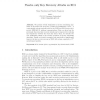302 search results - page 35 / 61 » Using Attack Injection to Discover New Vulnerabilities |
GECCO
2008
Springer
13 years 9 months ago
2008
Springer
Computer networks have expanded significantly in use and numbers. This expansion makes them more vulnerable to attack by malicious agents. Many current intrusion detection systems...
EUROSYS
2008
ACM
14 years 5 months ago
2008
ACM
Eudaemon is a technique that aims to blur the borders between protected and unprotected applications, and brings together honeypot technology and end-user intrusion detection and ...
NSDI
2008
13 years 10 months ago
2008
Using statistical machine learning for making security decisions introduces new vulnerabilities in large scale systems. This paper shows how an adversary can exploit statistical m...
GI
2003
Springer
14 years 1 months ago
2003
Springer
: Our current societies are fully dependent on large complex critical infrastructures (LCCIs). These LCCIs are large scale distributed systems that are highly interdependent, both ...
SACRYPT
2007
Springer
14 years 2 months ago
2007
Springer
Abstract. We present several weaknesses in the key scheduling algorithm of RC4 when the secret key contains an initialization vector – a cryptographic scheme typically used by th...


